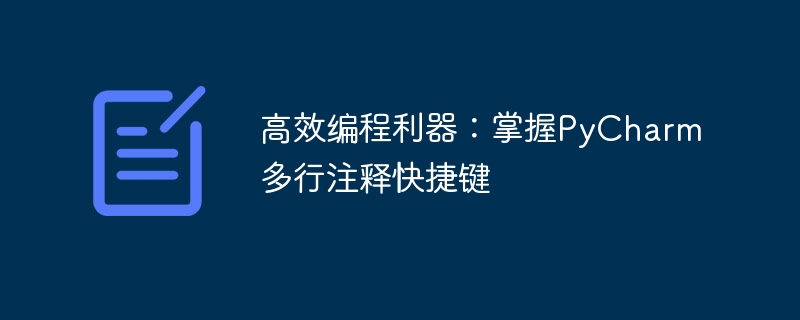

Efficient programming tool: Master the PyCharm multi-line comment shortcut keys
In recent years, with the popularity of the Python programming language, more and more developers have begun to choose to use it PyCharm serves as their integrated development environment (IDE). PyCharm provides many powerful features and tools to help developers write and debug Python code more efficiently. Among them, mastering PyCharm's multi-line comment shortcut keys is a very important skill. This article will introduce this function in detail and provide specific code examples.
1. What is a multi-line comment?
In the process of writing code, we often use comments. Comments are text that explains and explains the code. They will not be executed by the compiler or interpreter, but are just to help developers understand the function and logic of the code. Comments in Python start with the # character, and the following text is considered a comment.
Single-line comments are very simple and clear, but when multiple lines of code need to be commented, using multi-line comments will be more convenient and intuitive. Multi-line comments start with ''' or """ and end with ''' or """. In PyCharm, we can quickly comment multiple lines of code through shortcut keys.
2. PyCharm multi-line comment shortcut key
In PyCharm, use Ctrl / (Windows) or Command / (Mac) shortcut keys to quickly comment out single lines of code. But for multiple lines of code, we need to use different shortcut keys.
Sample code:
# 这是一段需要注释的代码
# print("Hello, World!")
# print("Welcome to PyCharm")Commented code:
"""
这是一段需要注释的代码
print("Hello, World!")
print("Welcome to PyCharm")
"""Another shortcut key is Ctrl Shift / (Windows) or Command Shift / (Mac). Use this shortcut key to quickly add/delete multi-line comments.
Sample code:
# 这是一段需要注释的代码
print("Hello, World!")
print("Welcome to PyCharm")Commented code:
"""
这是一段需要注释的代码
print("Hello, World!")
print("Welcome to PyCharm")
"""3. Summary
Mastering PyCharm’s multi-line comment shortcut keys can help Developers write and manage code more efficiently. Whether you're commenting an entire function, class, or piece of code, using multiline comments can make your code clearer and more readable. By using the shortcut key Ctrl / or Ctrl Shift /, we can easily add and delete multi-line comments in PyCharm.
In actual development, multi-line comments not only help to add explanations and explanations to the code, but also provide teammates with better code understanding and maintenance convenience. Therefore, mastering PyCharm's multi-line comment shortcut keys is one of the very useful skills for programmers.
I hope this article will help you understand and master the PyCharm multi-line comment shortcut keys. I hope you can improve efficiency in the programming process and write better Python code!
The above is the detailed content of Improve programming efficiency: Master multi-line comment shortcuts using PyCharm. For more information, please follow other related articles on the PHP Chinese website!
 direct3d function is not available
direct3d function is not available
 My computer can't open it by double-clicking it.
My computer can't open it by double-clicking it.
 Introduction to software development tools
Introduction to software development tools
 Usage of Type keyword in Go
Usage of Type keyword in Go
 Introduction to the main work content of the backend
Introduction to the main work content of the backend
 Tutorial on buying and selling Bitcoin on Huobi.com
Tutorial on buying and selling Bitcoin on Huobi.com
 How to use countif function
How to use countif function
 What currency is PROM?
What currency is PROM?




